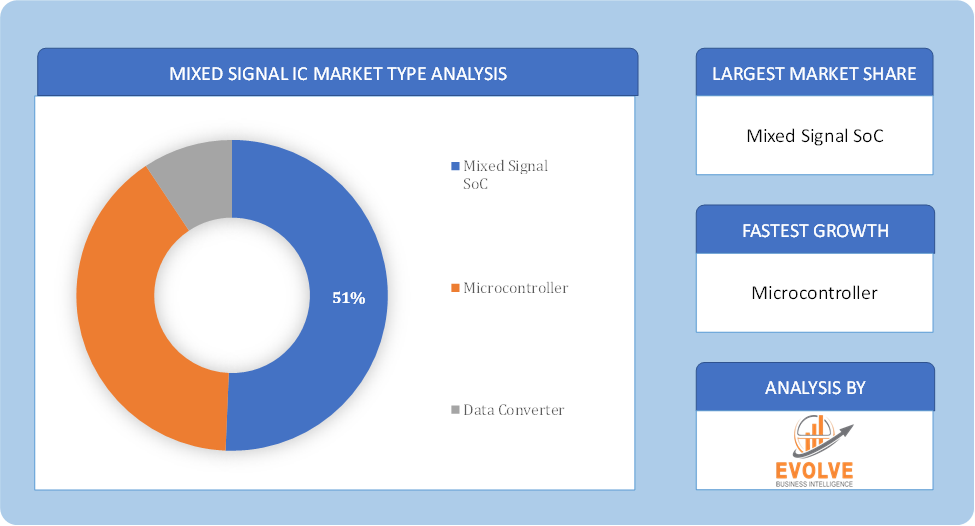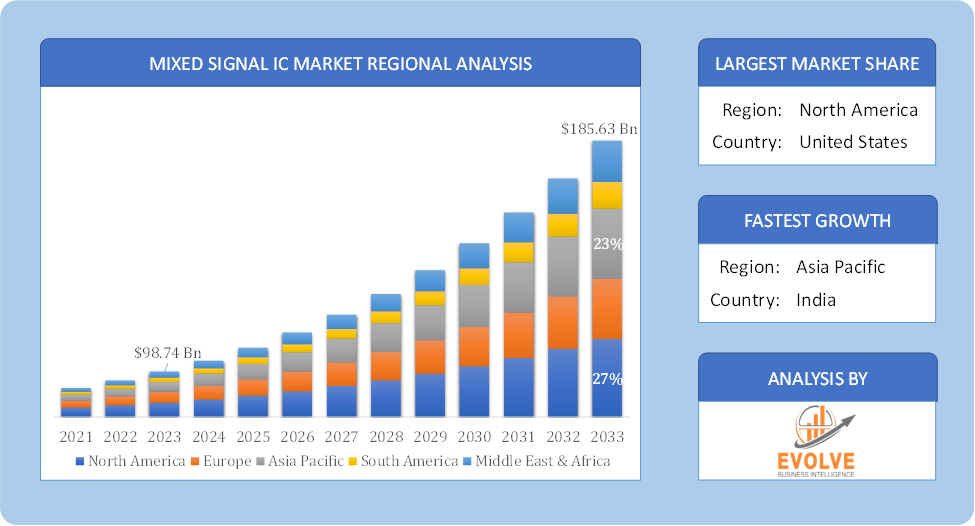Mixed Signal IC Market Overview
The Mixed Signal IC Market Size is expected to reach USD 185.63 Billion by 2033. The Mixed Signal IC Market industry size accounted for USD 98.74 Billion in 2023 and is expected to expand at a compound annual growth rate (CAGR) of 6.74% from 2023 to 2033. The Mixed Signal IC (Integrated Circuit) Market refers to the global industry involved in the design, manufacturing, and sale of mixed signal integrated circuits. These ICs combine both analog and digital circuitry on a single semiconductor chip, allowing them to handle both analog and digital signals.
The Mixed Signal IC Market is expected to grow steadily due to the increasing integration of electronics in everyday devices and the continuous advancements in semiconductor technology. The market is driven by innovations in areas like 5G, IoT, and AI, which require sophisticated ICs capable of handling both analog and digital signals efficiently.
Global Mixed Signal IC Market Synopsis
 COVID-19 Impact Analysis
COVID-19 Impact Analysis
The COVID-19 pandemic had significant impacts on the Mixed Signal IC Market. The demand for medical devices and diagnostic equipment surged, driving the need for mixed signal ICs. The rise in remote work and online education led to increased sales of laptops, tablets, and other consumer electronics, boosting the market. The expansion of communication infrastructure to support increased internet traffic and remote connectivity drove demand for mixed signal ICs used in networking equipment. The need to minimize human presence in industrial settings accelerated the adoption of automation technologies, benefiting the mixed signal IC market. The pandemic accelerated the adoption of IoT devices for various applications, increasing the need for sophisticated mixed signal ICs. Lockdowns and restrictions in various countries disrupted the production of semiconductor components, leading to delays and shortages. Companies in the mixed signal IC market have adapted to new ways of working, with increased emphasis on digital tools and remote collaboration. The pandemic highlighted the need for more resilient and flexible supply chains, prompting investments in supply chain management and diversification.
Mixed Signal IC Market Dynamics
The major factors that have impacted the growth of Mixed Signal IC Market are as follows:
Drivers:
Ø Advancements in Automotive Technology
The development of ADAS technologies, including lane-keeping assist, adaptive cruise control, and automatic emergency braking, requires mixed signal ICs for sensor fusion and signal processing. The shift towards electric vehicles (EVs) and the advancement of autonomous driving technologies drive demand for mixed signal ICs for battery management, power electronics, and vehicle-to-everything (V2X) communication. There is a growing emphasis on energy efficiency in electronic devices and systems, which drives the need for mixed signal ICs used in power management, conversion, and optimization. The push for environmentally friendly technologies and renewable energy solutions creates opportunities for mixed signal ICs in areas such as solar power systems and energy-efficient electronics.
Restraint:
- Perception of High Design Complexity and Cost
Designing mixed signal ICs requires integrating both analog and digital components on a single chip, which is technically challenging and time-consuming. The complexity of design and the need for advanced tools and expertise lead to higher development costs, making it difficult for smaller companies to compete. The risk of patent infringement and the complexities of intellectual property rights can pose significant challenges for companies operating in the mixed signal IC market. Licensing necessary technologies and IP can add to the overall cost of developing and manufacturing mixed signal ICs.
Opportunity:
⮚ Growth in Healthcare and Medical Devices
The increasing popularity of wearable health monitoring devices, such as fitness trackers and medical wearables, creates a demand for mixed signal ICs for sensor integration and data processing. The advancement of diagnostic equipment and remote patient monitoring systems drives the need for mixed signal ICs for accurate data acquisition and signal processing. The global rollout of 5G networks requires mixed signal ICs for base stations, small cells, and user devices to handle high-speed data transmission and low-latency communication. The expansion of broadband and wireless communication technologies creates opportunities for mixed signal ICs in networking equipment and consumer devices.
Mixed Signal IC Market Segment Overview
 By Type
By Type
Based on Type, the market is segmented based on Mixed Signal SoC, Microcontroller and Data Converter. The Mixed Signal SoC segment dominant the market. The mixed signal IC market is experiencing robust growth, driven by the consumer electronics sector’s increasing demand for advanced, portable, and energy-efficient devices. Key components of this market include sensor interfaces, audio codecs, and power management ICs, which are integral to wearables, smartphones, and IoT devices.
By End User
Based on End User, the market segment has been divided into the Consumer Electronics, Medical & Healthcare, Telecommunication, Automotive and Military & Defense. The Consumer Electronics segment dominant the market. Increasing demand for portable computing devices with longer battery life and high performance boosts the need for efficient mixed signal ICs and it’s driven by continuous innovation and increasing consumer demand for advanced, interconnected devices.
Global Mixed Signal IC Market Regional Analysis
Based on region, the global Mixed Signal IC Market has been divided into North America, Europe, Asia-Pacific, the Middle East & Africa, and Latin America. North America is projected to dominate the use of the Mixed Signal IC Market followed by the Asia-Pacific and Europe regions.
 Mixed Signal IC North America Market
Mixed Signal IC North America Market
North America holds a dominant position in the Mixed Signal IC Market. North America, particularly the United States, is a leader in technological innovation, with a strong focus on advanced semiconductor technologies. The presence of major automotive manufacturers and the adoption of electric and autonomous vehicles drive demand for mixed signal ICs. The growth of the medical device industry and increased investment in healthcare technology contribute to market growth.
Mixed Signal IC Asia-Pacific Market
The Asia-Pacific region has indeed emerged as the fastest-growing market for the Mixed Signal IC Market industry. Asia-Pacific, particularly China, South Korea, and Japan, is a major hub for consumer electronics manufacturing, driving significant demand for mixed signal ICs. Rapid deployment of 5G networks and strong growth in telecommunications infrastructure. Increasing production and adoption of electric vehicles and advancements in automotive technologies. Growth in industrial automation and smart manufacturing.
Competitive Landscape
The global Mixed Signal IC Market is highly competitive, with numerous players offering a wide range of software solutions. The competitive landscape is characterized by the presence of established companies, as well as emerging startups and niche players. To increase their market position and attract a wide consumer base, the businesses are employing various strategies, such as product launches, and strategic alliances.
Prominent Players:
- Analog Devices
- Broadcom Inc.
- Cypress Semiconductor Corporation
- Dialog Semiconductor
- Ensilica Ltd
- NXP Semiconductor
- Renesas Electronics Corporation
- STMicroelectronics
- Telephonics Corporation
- Texas Instrument
Scope of the Report
Global Mixed Signal IC Market, by Type
- Mixed Signal SoC
- Microcontroller
- Data Converter
Global Mixed Signal IC Market, by End User
- Consumer Electronics
- Medical & Healthcare
- Telecommunication
- Automotive
- Military & Defense
Global Mixed Signal IC Market, by Region
- North America
- US
- Canada
- Mexico
- Europe
- UK
- Germany
- France
- Italy
- Spain
- Benelux
- Nordic
- Rest of Europe
- Asia Pacific
- China
- Japan
- South Korea
- Indonesia
- Austalia
- Malaysia
- India
- Rest of Asia Pacific
- South America
- Brazil
- Argentina
- Rest of South America
- Middle East & Africa
- Saudi Arabia
- UAE
- Egypt
- South Africa
- Rest of Middle East & Africa
| Parameters | Indicators |
|---|---|
| Market Size | 2033: USD 185.63 Billion |
| CAGR (2023-2033) | 6.74% |
| Base year | 2022 |
| Forecast Period | 2023-2033 |
| Historical Data | 2021 (2017 to 2020 On Demand) |
| Report Coverage | Revenue Forecast, Competitive Landscape, Growth Factors, and Trends |
| Key Segmentations | Type, End User |
| Geographies Covered | North America, Europe, Asia-Pacific, South America, Middle East, Africa |
| Key Vendors | Analog Devices, Broadcom Inc., Cypress Semiconductor Corporation, Dialog Semiconductor, Ensilica Ltd, NXP Semiconductor, Renesas Electronics Corporation, STMicroelectronics, Telephonics Corporation and Texas Instrument. |
| Key Market Opportunities | · Growth in Healthcare and Medical Devices · Telecommunications and 5G Deployment |
| Key Market Drivers | · Advancements in Automotive Technology · Increased Focus on Energy Efficiency |
REPORT CONTENT BRIEF:
- High-level analysis of the current and future Mixed Signal IC Market trends and opportunities
- Detailed analysis of current market drivers, restraining factors, and opportunities in the future
- Mixed Signal IC Market historical market size for the year 2021, and forecast from 2023 to 2033
- Mixed Signal IC Market share analysis at each product level
- Competitor analysis with detailed insight into its product segment, Government & Defense strength, and strategies adopted.
- Identifies key strategies adopted including product launches and developments, mergers and acquisitions, joint ventures, collaborations, and partnerships as well as funding taken and investment done, among others.
- To identify and understand the various factors involved in the global Mixed Signal IC Market affected by the pandemic
- To provide a detailed insight into the major companies operating in the market. The profiling will include the Government & Defense health of the company’s past 2-3 years with segmental and regional revenue breakup, product offering, recent developments, SWOT analysis, and key strategies.


 Mixed Signal IC North America Market
Mixed Signal IC North America Market


